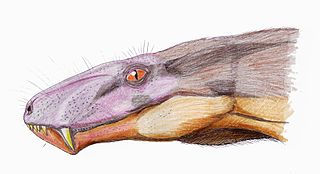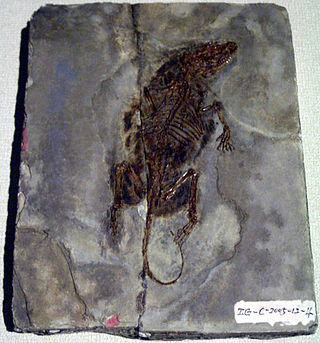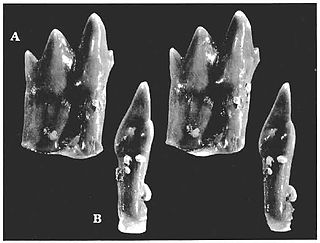Hahnodon is an extinct genus of mammaliaforms from the Early Cretaceous Ksar Metlili Formation in Morocco. Although originally considered to be a relatively early member of the extinct clade Multituberculata, recent studies indicate that it instead is a haramiyid.
Hahnodontidae is a family of extinct mammaliaforms from Early Cretaceous deposits in Morocco and the Western United States. Although originally considered to belong to the extinct clade Multituberculata, recent work indicates that hahnodontids belong to the more primitive clade Haramiyida.

Haramiyida is a possibly paraphyletic order of mammaliaform cynodonts or mammals of controversial taxonomic affinites. Their teeth, which are by far the most common remains, resemble those of the multituberculates. However, based on Haramiyavia, the jaw is less derived; and at the level of evolution of earlier basal mammals like Morganucodon and Kuehneotherium, with a groove for ear ossicles on the dentary. Some authors have placed them in a clade with Multituberculata dubbed Allotheria within Mammalia. Other studies have disputed this and suggested the Haramiyida were not crown mammals, but were part of an earlier offshoot of mammaliaformes instead. It is also disputed whether the Late Triassic species are closely related to the Jurassic and Cretaceous members belonging to Euharamiyida/Eleutherodontida, as some phylogenetic studies recover the two groups as unrelated, recovering the Triassic haramiyidians as non-mammalian cynodonts, while recovering the Euharamiyida as crown-group mammals closely related to multituberculates.

Sauroctonus is an extinct genus of gorgonopsian therapsids who lived during the end of the Middle Permian in what is now European Russia. The first fossils, discovered in Tatarstan, were initially believed to belong to a new species of the South African genus Arctognathus. The taxon was designated as such until 1940, when it was assigned to the genus Inostrancevia by Ivan Yefremov, before being definitively classified in a separate genus erected by Alexey Bystrow. The most complete, known fossils of S. progressus include cranial and postcranial elements, currently all recorded from Tatarstan. These elements show that the animal was a mid-sized gorgonopsian.

Cyonosaurus is a genus of gorgonopsian therapsids from the late Permian of South Africa. Some skulls have been reported from Early Triassic strata, but further investigation revealed that these reports were erroneous. Cyonosaurus was 0.6 to 1.1 metres in length, with a skull 9 to 18 centimetres in length. The type species Cyonosaurus longiceps was named in 1937.

Trechnotheria is a group of mammals that includes the therians and some fossil mammals from the Mesozoic Era. It includes both the extinct symmetrodonts and the living Cladotheria.
Pantotheria is an abandoned taxon of Mesozoic mammals. This group is now considered an informal "wastebasket" taxon and has been replaced by Dryolestida as well as other groups. It is sometimes treated as an infraclass and older books refer to it as being related to symmetrodonts. One classification makes it an infraclass with a single order, Eupantotheria.

Hipposaurus is an extinct genus of basal therapsids known from the Tapinocephalus Assemblage Zone of the Main Karoo Basin, South Africa. Chronologically this is within the Capitanian stage of the Guadalupian Series. The genus was first described by S.H. Haughton as H. boonstrai on the basis of a skull and associated skeleton and was later considered a gorgonopsian in the family 'Ictidorhinidae' by Robert Broom. It is now considered a basal biarmosuchian, but its affinities remain uncertain. Some authors note the similarity of its braincase with that of Herpetoskylax. H. boonstrai is currently known from only two specimens in the Iziko South African Museum, Cape Town.
Tinodon is an extinct genus of mammal alive 155–140.2 million years ago (Oxfordian-Berriasian) which has been found in the Morrison Formation, the Alcobaça Formation (Portugal) and the Lulworth Formation (England). It is of uncertain affinities, being most recently recovered as closer to therians than eutriconodonts but less so than allotherians. Two species are known: T. bellus and T. micron.
Dorsetodon is an extinct genus of mammal from the Early Cretaceous (Berriasian) Purbeck Group of Britain. It is represented by isolated lower molars.
Ruthenosaurus is an extinct genus of caseid synapsids that lived in what is now Southern France during the Early Permian about 285 million years ago. It is known from the holotype MNHN.F.MCL-1 an articulated partial postcranial skeleton. It was collected by D. Sigogneau-Russell and D. Russell in 1970 in the upper part of the M2 Member, Grès Rouge Group, in the Rodez Basin, near the village of Valady, in Occitanie Region. It was first named by Robert R. Reisz, Hillary C. Maddin, Jörg Fröbisch and Jocelyn Falconnet in 2011, and the type species is Ruthenosaurus russellorum.

Euromycter is an extinct genus of caseid synapsids that lived in what is now Southern France during the Early Permian about 285 million years ago. The holotype and only known specimen of Euromycter (MNHN.F.MCL-2) includes the complete skull with lower jaws and hyoid apparatus, six cervical vertebrae with proatlas, anterior part of interclavicle, partial right clavicle, right posterior coracoid, distal head of right humerus, left and right radius, left and right ulna, and complete left manus. It was collected by D. Sigogneau-Russell and D. Russell in 1970 at the top of the M1 Member, Grès Rouge Group, near the village of Valady, Rodez Basin. It was first assigned to the species "Casea" rutena by Sigogneau-Russell and Russell in 1974. More recently, it was reassigned to its own genus, Euromycter, by Robert R. Reisz, Hillary C. Maddin, Jörg Fröbisch and Jocelyn Falconnet in 2011. The preserved part of the skeleton suggests a size between 1,70 m (5,5 ft) and 1,80 m (5,9 ft) in length for this individual.
Purbeckodon is an extinct genus of mammaliaforms, possibly belonging to Morganucodonta, that is known from Early Cretaceous deposits of southeastern Dorset, England. It was collected in the Purbeck Limestone Group of Dorset. It was first named by Percy M. Butler, Denise Sigogneau-Russell and P. C. Ensom in 2011 and the type species is Purbeckodon batei.

Dyskritodon is a genus of extinct mammal from the Early Cretaceous of Morocco, and possibly the Early Jurassic of India. Of uncertain affinities, it is tentatively described as a eutriconodont.
Cyrtlatherium is a dubious genus of extinct docodontan mammaliaform from the Middle Jurassic rocks of Oxfordshire, England. As it is only known from a few isolated molar teeth, there is disagreement about whether Cyrtlatherium is a separate genus, or whether it is a synonym and the molar teeth are the deciduous teeth of another genus of docodont.
Thereuodon is a genus of extinct mammal known from the Early Cretaceous of southern England, Morocco and France. The type species, named by Denise Sigogneau-Russell in 1989 for teeth from the earliest Cretaceous Ksar Metlili Formation of Morocco, is Thereuodon dahmani, while the referred species named by Sigogneau-Russell and Paul Ensom for teeth from the Lulworth Formation of England is Thereuodon taraktes. The two species are separated by a break in the cingulum in T. dahmani, a more obtuse medial crest in T. taraktes, a duller stylocone in T. taraktes, a "c" cuspule in T. dahmani, and a reduced facet A in T. taraktes. The genus Thereuodon is the only taxon in the symmetrodont family Thereuodontidae, which may be closely related to Spalacotheriidae. A tooth referred to T. cf. taraktes is known from the Berriasian aged Angeac-Charente bonebed of France.
Denise Sigogneau-Russell is a French palaeontologist who specialises in mammals from the Mesozoic, particularly from France and the UK. She is currently based at the Muséum National d'Histoire Naturelle.
Delsatia is an early mammaliaform genus that lived during the Late Triassic and has been found in the Gres infralisiques Formation of France. The type species, D. rhupotopi, was named in 1997. It was originally tentatively placed within the Docodonta, but subsequent studies disagree with this; Delsatia is seen by most as a basal mammaliaform. The holotype, MNHN.F.SNP408W, is an incomplete, isolated tooth.
Cherwellia is an extinct genus of mammaliaforms, possibly belonging to Morganucodonta, that lived in what is now England during the Middle Jurassic. The type and only known species is Cherwellia leei. It was first described in 2016 by Percy M. Butler and Denise Sigogneau-Russell from a single lower molar found at the Kirtlington Quarry of the Forest Marble Formation.
Stylidens is an extinct genus of mammaliaforms, possibly belonging to Morganucodonta, that lived in what is now England during the Middle Jurassic. Its type species is Stylidens hookeri, which was named in 2016 by Percy M. Butler and Denise Sigogneau-Russell from an isolated lower molar found at the Forest Marble Formation. A second molar referable to the genus is also known, which may represent a separate species.







